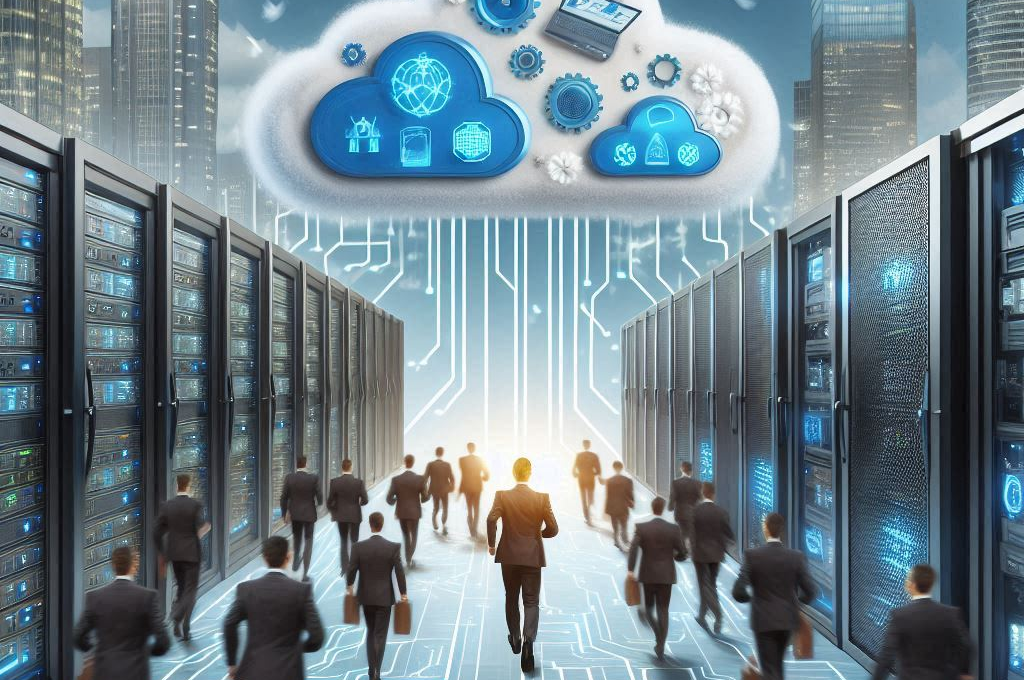In today’s digital world, storing, processing, and securing data is critical for every enterprise. Traditionally, companies relied on physical data centers to manage these operations. However, the rise of cloud services has transformed how businesses think about scalability, cost, performance, and agility.
Let’s unpack the differences between traditional data centers and cloud services, and explore how enterprises can kickstart their cloud journey on platforms like AWS, Azure, and Google Cloud.
What is a Data Center?
A Data Center is a physical facility that organizations use to house their critical applications and data. Companies either build their own (on-premises) or rent space in a colocation center (third-party facility). It includes:
- Servers
- Networking hardware
- Storage systems
- Cooling units
- Power backups
Examples of Enterprises Using Data Centers:
- JPMorgan Chase runs tightly controlled data centers due to strict regulatory compliance.
- Telecom companies often operate their own private data centers to manage sensitive subscriber data.
What is Cloud Computing?
Cloud computing refers to delivering computing services – servers, storage, databases, networking, software – over the internet. Cloud services are offered by providers like:
- Amazon Web Services (AWS)
- Microsoft Azure
- Google Cloud Platform (GCP)
Cloud services are typically offered under three models:
1. Infrastructure as a Service (IaaS)
Example: Amazon EC2, Azure Virtual Machines
You rent IT infrastructure—servers, virtual machines, storage, networks.
2. Platform as a Service (PaaS)
Example: Google App Engine, Azure App Service
You focus on app development while the platform manages infrastructure.
3. Software as a Service (SaaS)
Example: Salesforce, Microsoft 365, Zoom
You access software via a browser; everything is managed by the provider.
Instead of owning and maintaining hardware, companies can “rent” what they need, scaling up or down based on demand.
Examples of Enterprises Using Cloud:
- Netflix runs on AWS for content delivery at scale.
- Coca-Cola uses Azure for its data analytics and IoT applications.
- Spotify migrated to Google Cloud to better manage its music streaming data.
Data Center vs. Cloud: A Side-by-Side Comparison
| Feature | Data Center | Cloud |
|---|---|---|
| Ownership | Fully owned and managed by the organization | Infrastructure is owned by provider; pay-as-you-go model |
| CapEx vs. OpEx | High Capital Expenditure (CapEx) | Operating Expenditure (OpEx); no upfront hardware cost |
| Scalability | Manual and time-consuming | Instantly scalable |
| Maintenance | Requires in-house or outsourced IT team | Provider handles hardware and software maintenance |
| Security | Fully controlled, suitable for sensitive data | Shared responsibility model; security depends on implementation |
| Deployment Time | Weeks to months | Minutes to hours |
| Location Control | Absolute control over data location | Region selection possible, but limited to provider’s availability |
| Compliance | Easier to meet specific regulatory needs | Varies; leading cloud providers offer certifications (GDPR, HIPAA, etc.) |
When to Choose Data Centers
You might lean toward on-premise data centers if:
- You operate in highly regulated industries (e.g., banking, defense).
- Your applications demand ultra-low latency or have edge computing needs.
- You already have significant investment in on-prem infrastructure.
When to Choose Cloud
Cloud becomes a better option if:
- You’re looking for faster time-to-market.
- Your workloads are dynamic or seasonal (e.g., e-commerce during festive sales).
- You want to shift from CapEx to OpEx and improve cost flexibility.
- You’re adopting AI/ML, big data analytics, or IoT that need elastic compute.
Hybrid Cloud: The Best of Both Worlds?
Many organizations don’t choose one over the other – they adopt a hybrid approach, blending on-premise data centers with public or private cloud.
For example:
- Healthcare providers may store patient data on-prem while running AI diagnosis models on the cloud.
- Retailers may use cloud to handle peak-season loads and retain their core POS systems on-premise.
How to Start Your Cloud Journey
Here’s a quick roadmap for enterprises just getting started:
- Assess Cloud Readiness – Perform a cloud readiness assessment.
- Choose a Cloud Provider – Evaluate based on workload, data residency, ecosystem.
- Build a Cloud Landing Zone – Setup account, governance, access, security.
- Migrate a Pilot Project – Start small with a non-critical workload.
- Upskill Your Team – Cloud certifications (AWS, Azure, GCP) go a long way.
- Adopt Cloud FinOps – Optimize and monitor cloud spend regularly.
Final Thoughts
Migrating to the cloud is a journey, not a one-time event. Follow this checklist to ensure a smooth transition: 1. Plan → 2. Assess → 3. Migrate → 4. Optimize
Additional Resources:
https://www.techtarget.com/searchcloudcomputing/definition/hyperscale-cloud
https://www.checkpoint.com/cyber-hub/cyber-security/what-is-data-center/data-center-vs-cloud
https://aws.amazon.com/what-is/data-center
